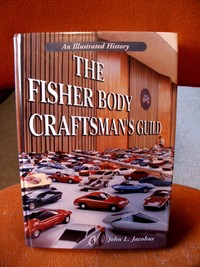An Illustrated History of The Fisher Body Craftman's Guild
TheAutoChannel Book Review
An Illustrated History of The Fisher Body Craftman's Guild
By John L. Jacobus McFarland & Company www.mcfarlandpub.com
Imagine you’re a teenage boy in the 1950s standing in the hall of a magnificent city hotel wearing the blazer and beret given to you by General Motors Corporation in honor of your selection as a finalist in this prestigious car-modeling contest. You’ve never been away from home except for summer camp. Now you’re waiting to file into the huge ballroom with dozens of other boys from around the country who have also won their regional competitions. You hear an orchestra playing inside. You’re breathing deeply. Cradled in your clammy hands is the model car you spent hundreds and hundreds of hours designing and crafting to perfection. If you are chosen one of the national winners, the future as a car designer you’ve lusted for is virtually assured.
Inside the ballroom hundreds of guests are seated as the GM executives and other dignitaries wearing white dinner jackets file into their seats on the long dais. In the center of that auspicious group is larger-than-life GM design chief Harley Earl, the only one in a black dinner jacket. He always liked to stand out in a crowd. Among the dignitaries are legendary “Boss” Kettering, the presidents of MIT and Cal Tech and keynote speaker, Lowell Thomas.
The Fisher Body Craftsman’s Guild was created in 1930 as a way for the Fisher Body Division of General Motors to identify and recruit talented youngsters to become craftsmen for the company. The first competition consisted of constructing a model Napoleonic Coach that was the symbol for Fisher Body, which tested a youngster’s ability to meticulously follow a design. In 1937 the competition was revised requiring participants to actually design and construct model automobiles, usually with a futuristic theme. In 1940 the coach building competition was ended and the car modeling continued until the program was scuttled in 1968, except for a hiatus during WWII.
John Jacobus’ book masterfully and meticulously details the history of the Guild, the challenges of the competition and the interesting people involved with the program. He thoroughly covers the history of the program, how youngsters were recruited, how the judging was done, and a myriad of other topics. It’s a great read for anyone interested in automobile design.



